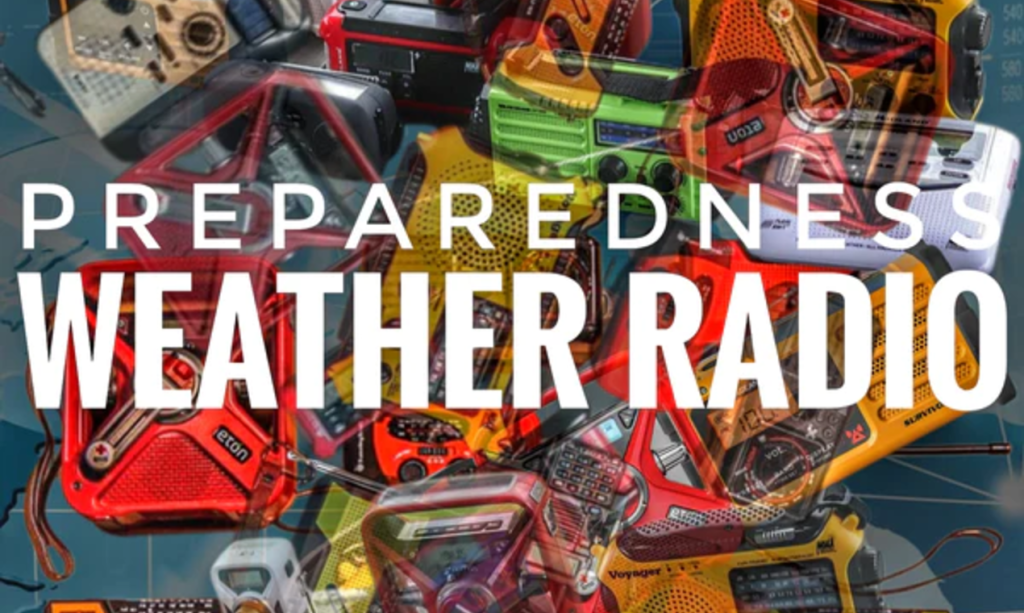Buy an NOAA radio and know how to tune to the “Weather Channel.” Use radio to stay in the know and informed of emergencies and weather impacting your region.
Radio Specs & Summary
Range/reception from source antenna is great (25mi-300mi with theoretical 3000+ mi), so this makes radio an ideal communication device when away from urban areas. The cost to own this radio is low ($30 to $200). They are easy to use and a license is not required. The primary purpose is to receive and listen to weather/alerts.
NOAA Weather Radios
A National Oceanic and Atmospheric Administration (NOAA) Weather Radio (NWR) is an automated 24-hour network of 100+ radio stations across the U.S. that broadcast weather information directly from local National Weather Service stations.
A broadcast cycle lasts about 3-8 minutes, featuring weather forecasts and local observations. It can be interrupted when severe weather advisories/warnings/watches are issued. It occasionally broadcasts other non-weather related events such as national security statements, natural disaster information, and environmental and public safety statements (such as an AMBER Alert) sourced from the FCC’s Emergency Alert System.
There are many “Weather Only” radios and standard radios that offer NOAA channels and have other features that manufacturers add as they see fit, but not all-weather radios are created equal. Always look for a NOAA Public Alert certified radio.
A NOAA Public Alert Certified All Hazards Weather Radio must meet listed requirements to earn the NOAA Public Alert certification. Many preppers who live in other parts of the country don’t understand their capabilities or why every prepper should own at least one.
Radio Features
》Tone Alarm – The National Weather Service sends a tone alarm before most warnings and watch messages are broadcast. This tone will turn on radios equipped with a tone alarm even if they’re turned off to ensure that you get important alerts. Without this feature, users tend to sleep through important warnings.
》SAME Technology –Same Area Message Encoder enabled radios are programmable. SAME enables the user to program the radio to only alert them about severe weather hazards that occur in the County programmed.
》Selectable Alerting of Events – Further allows operator to turn off alarms for events that they don’t apply to them.
》External Antenna or Device Jack – Add an antenna to improve reception or other appliance for added features.
Radio Recap
These radios are essential for warning you and your family during sleeping hours of weather and other hazards.
The radios stay silent until activated by a special signal issued by the National Weather Service. The radio then sounds an alarm and displays the hazard information. You may also find an additional benefit by turning the radio portion on (see manufacturer instructions) to receive the weather forecast for the day.
Once the radio is purchased, it doesn’t cost any additional amount, except for purchasing new batteries for the backup battery feature. Most radios perform an audible weekly test on Wednesdays between 10:00 am and 12:00 pm.
Maintenance
The radios are low-maintenance and do not require much attention to continue working properly. It is important to check the radio’s functionality and signal during the weekly test that takes place every Wednesday between 10:00 am and 12:00 pm. You should refer to the instructions provided by the manufacturer on how to check and change the backup batteries, and replace them at least twice a year or more frequently if needed, especially in the case of a prolonged power outage lasting more than 48 hours. If you follow the manufacturer’s instructions, the radio should provide reliable service for a long time.
Reminder
Receiving warning information is only one part of being safe during weather emergencies. Knowing what to do when the weather watch or warning is issued is just as important, if not more. Practice with your family what you will do for weather watches and warnings. We encourage you to practice your plan at least quarterly, just as you should do with home fire drills.
Basic Weather Preparedness
Stay up-to-date on weather patterns and conditions by monitoring weather reports and warnings issued by your local authorities and the National Weather Service.
Be prepared with an emergency kit that includes enough food, water, medication, flashlights, extra batteries, a first aid kit, and a radio to last for at least three days.
Develop a plan for severe weather emergencies that outlines what you will do and where you will go, and make sure to communicate the plan with family and friends.
Prepare your home for severe weather by trimming trees, securing outdoor items, and reinforcing windows and doors.
If local authorities recommend evacuation, follow their instructions and evacuate immediately.
Stay informed during and after the storm by monitoring weather reports and warnings, and be aware of post-storm hazards like flooding and downed power lines.
This article was originally written by the Grayman Briefing. Stay in the know, sign up for Intel and Situational Awareness alerts pushed to your phone on emerging threats and preparedness warnings. Click HERE to subscribe to the Grayman Briefing.
=====
Become a Survival Dispatch Insider …
We bring together survival enthusiasts and preppers to share skills and knowledge, so you can enhance your preparedness for emergencies and ensure the safety of you and your community.
The Results You’ll Get …
Our community, courses, and memberships are pretty special. We’re focused on the ways it will make a huge difference in your life.
Here are a few of the things you’ll be able to do as a member of Survival Dispatch Insider …
1) Improve your emergency preparedness by learning survival skills and strategies from experienced preppers.
2) Build lasting connections with like-minded individuals that share your passion for safety and readiness.
3) Access a wealth of knowledge and resources to assist in protecting you and your community during unexpected situations.
Click HERE to get started.
=====


